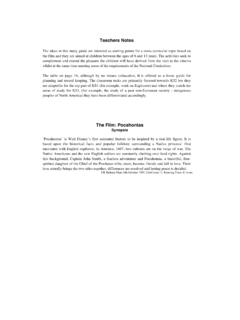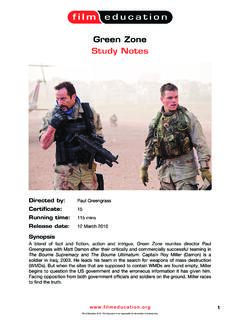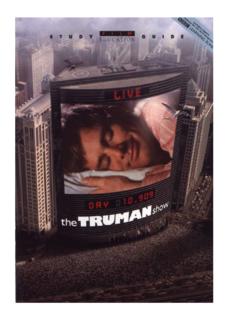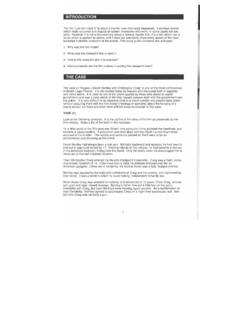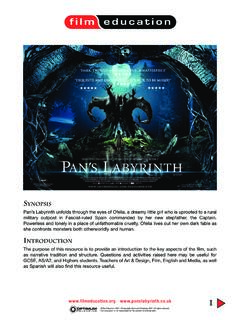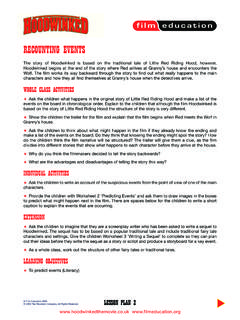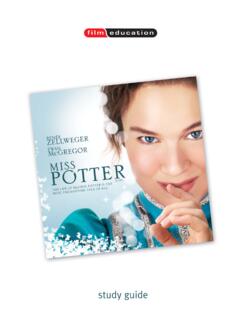Transcription of FE041 Ice Age SG - Film Education
1 ' NOTESB rought to you from film Education and Twentieth Century Fox, this resource can be used as across-curricular project based on the characters and story in Fox's new animated feature film , Ice Age. This study guide features photocopiable activities aimed at pupils at Key Stages 1/2. Thecurriculum links are outlined on each page, and in more detail in the curriculum grid on theinside back cover. The subject focus areas for this study guide are Literacy, History,Geography, ICT and activities can be integrated into your timetable whether or not you take your pupils tosee Ice Ageat the cinema. You may find, however, that a class trip to see the film willenhance the learning experience. Some cinema managers are willing to offer special schoolscreenings at a reduced rate. Contact your local cinema manager to find out.
2 SYNOPSIST wenty thousand years ago, the Earth was being overrun by glaciers, and creatures everywhere werefleeing the onslaught of the new Ice Age. In this time of peril, we meet the weirdest herd of any Age: afast talking but dim sloth named Sid; a moody woolly mammoth named Manny; a devilish sabre-toothedtiger named Diego; and an acorn-crazy sabre-toothed squirrel known as Scrat. This quartet of misfitsunexpectedly, and reluctantly, comes together in a quest to return a human infant to his father. Bravingboiling lava pits, treacherous ice caves, freezing temperatures and a secret, evil plot, these sub-zeros become the world's first heroes!Director:Chris WedgePreviews: 16th and 17th March 2002 Release date:22nd March 2002 Running time:90mins approxCertificate:U (tbc) objectives of this study guide are to: introduce children to the concept of the Ice Age strengthen their cognitive and problem solving skills in Literacy, History, Geography, ICT and Science take advantage of students' enthusiasm for film to promote creativity and imaginationAs you will see, the activities can be delivered across the curriculum.
3 Completion of all of the lessonactivities could take anything from a week to a term, depending on how you decide to work them intoyour planning. Lesson notes are provided with the contents. There is a Timeline for reference on pages 2 can be photocopied and either enlarged for display purposes or given to each child. There is aglossary of difficult words underlined on each activity sheet on page 12 which can be enlarged andphotocopied and given to each child for reference. COMPETITIONThe competition on page 8 gives your class the opportunity to win computer equipment for the class. Towin, the children must recreate the Ice Age in the classroom using the film images as inspiration,photograph the display and send it to: film Education , Alhambra House, 27-31 Charing Cross Road, London, WC2H OAUI nclude your name, class name, age and the full school address and telephone numberon the runners-up will win sets of Ice Agebooks and goody-bagsCOMPETITION TERMS AND CONDITIONS:This competition is open to all primary schools in the UK.
4 All entries must be received by Friday, 12th April 2002. Details of the winners will be published on film Education s website. Entry into this competitionallows film Education permission to use the winners name (and their school name) for publicity purposes. There will be no cash alternative to the prizes awarded. The judges decision is final and nocorrespondence will be entered into. We regret that we cannot return the entries. This competition is open to all primary pupils except for the relatives of employees of film Education and Twentieth Century film s official Education s award-winning interactive resource focused on the BBC 'Walking With Beasts' of the Natural History Museum in pages on mammoths from a museum in Hot Springs, out about Ice Age beasts through the migration maps and other about woolly for the Swedish Museum of Natural History which features resources on mammoths and other out about the rhino of the Ice out about Ice Age books from this websiteBackground information on the Ice AgeThe Ice Ages were periods of time when a great deal of the Earth's surface was covered with sheets of ice.
5 The filmIce Ageis set during the time of the last Ice Age, which occurred between 100,000 and 10,000 years ago. You mayhave seen examples of the types of beasts who populated the Earth at this time in the BBC series 'Walking withBeasts' ( ). Some of these strange, giant creatures also appear as characters in the filmIce Age, including those on page 4. ExtinctionNo one can say exactly why some animals became extinct at the end of the last Ice Age and why others did say it was because humans became good hunters whilst others say that animals caught diseases fromhumans. One theory suggests that the warm weather killed them off! Some scientists believe that the current warmclimate is preceding another Ice Age yet to and activity notes2/3 Timeline for the Cast of Ice Age these two pages provide an overview of the main characters featured in the filmIce Age Adventure this activity requires children to practice their sequencing skills.
6 Read the children the filmsynopsis and ask them to put the images into the order in which they think they appear in the film . Please notethe children will need the images on page 7 photocopied for them to complete the the Ice Age in your Classroom! Competition. Create an Ice Ageinspired classroom display andenter photos of it into the Ice Agecompetition to win computer equipment. 9 Sound Effects to make the sound effects for one of the scenes from the film using instruments and objectsfrom the Paintings in this challenging task, the children are asked to draw a design that will carry a message to future generations. 11 Ice, Ice, Baby this activity draws on creative writing skills through character role play and diary explanation of the difficult vocabulary underlined on each page.
7 (Enlarge for the children if necessary.)13 Curriculum Guidelines details of how each activity fits in the curriculum to ease up the underlinedwords in the glossary on page Million Years AgoOLIGOCENE34 - 24 Million Years AgoMIOC24 - MilliPALAEOCENE65-58 Million Years AgoDinosaurs extinctGrasslands emergeFirst lpredatory First horsesMOERITHERIUMPHIOMIADEINOTHERIUMSTE GP alaeocene Era65 - 58 million years ago dinosaurs became extinctaround 57 million yearsagoEocene Era57 - 35 million years ago first horses evolved North and South poles wereice free, but the Earth wasgetting coolerOligocene Era34 - 24 million years ago world cooled dramaticallykilling 20% of the Earth'sspeciesMiocene Era24 - million years ago first large predatoryanimals evolved some animals grew teethto eat the grass thatevolvedColour me in!
8 Look up the underlinedwords in the glossary on page Years - 2 Million Years AgoPLEISTOCENE2 Million - 10,000 Years AgoHOLOCENEB egan 10,000 years agoarge mammalsFirst HumansHumans use fireWoollyMammoths Pyramidsin EgyptWoolly Mammothsdie outGADONAMERICAN MASTODONFIRST MAMMOTHSP liocene - 2 million years ago first humans evolved Giant mammalsruledthe Earth - but their timewas about to endPleistocene Era2 million to 10,000 years ago humans learn to walk uprightandto use fire WoollyMammothswalked theEarth ice covered 30% of the Earth killinganimals, cave men and women last Ice Age occurredin this eraHolocene Era10,000 years ago to the present day Pyramids of Egypt were built last woollymammothsdie out modern humans survived(luckily for us!) Gilderson Print 2002 Colour me in too!
9 Look up the underlinedwords in the glossary on page TigerDiego is as big as a lion. He has big, strong front legs,short hindlegs and a short tail. He cannot run very fast,so he prefersto lie in wait for small mammalsto crosshis path. Diego s teeth are extremely sharp anddangerous, and he is not scared to use them when heis Siberiahave excavated a20,380-year-oldWoollyMammothSCRAT The 'scrat' is the one imaginaryanimal in the film ,Ice Age. This acorn obsessedslapstickstar is onlyreal on screen, but he is based on the earliestmammals that walked the Earth. These lookedlike a cross between squirrels and rats. They lived atthe time of the great dinosaurs. They stayed alive alot longer than the dinosaurs though - about 155million years longer!MANNYW oollyMammothWeighing 6-8 tons, the average woollymammothneeded 40 gallonsand 600 pounds of vegetationa day in order to stay alive.
10 That isa lot of greens! Manny is covered with a thick shaggy coat ofwoolly fur like the rest of his species. This is to keep him warm inthe cold climate. He also has four inches of insulatingfat and ahump of extra fat on his back to help him survivethe 's trunk has fleshy bits on the end like fingers thatcan wrap around objects. He uses his tusksto ploughthrough the snow to help him find foodSIDG iant SlothSid is a six-foot-tall, 1,500-pound primitivemammalrelatedto the modern-dayarmadilloand small tree slothsof Central and South America. He has flatgrindingteeth to help him chew his food. He likes to eat grass, leaves andbushes. Sid's enormous clawsare great for gathering bits of food together. Hehas a funny walk: this is because prehistoricslothswalked on their knucklesand the sides of their feet due to their big clawsgetting in the way!

